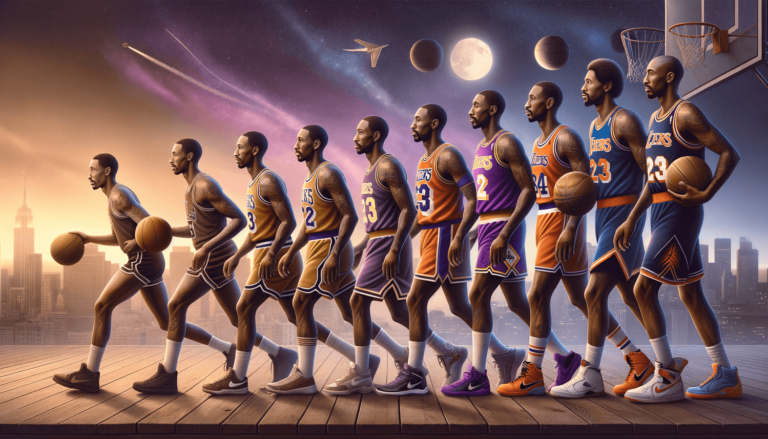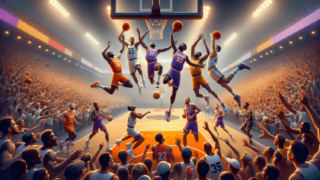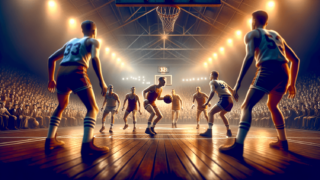
Evolution of Endorsement Deals in Basketball
Written by: Basketball Universe
Last updated:

From Chuck Taylor’s iconic sneakers to Michael Jordan’s game-changing partnership with Nike, the world of basketball has played a pioneering role in the evolution of endorsements deals. As the sport continues to gain popularity across the globe, its financial potential has grown too, with various lucrative business partnerships becoming an integral part of the game. In this fun, yet informative blog post, we’ll take you on a journey through the history of endorsement deals in basketball, spotlighting key milestones, eye-popping contracts, and trend-setting marketing strategies that have forever transformed the relationship between athletes, brands, and fans alike.
Evolution of Endorsement Deals in Basketball
The evolution of endorsement deals in basketball can be traced back to the early days of the sport, with the first significant deal being Chuck Taylor’s alliance with Converse in the 1920s. Over the years, endorsement deals have progressed alongside the sport’s growth in popularity and revenue, leading to groundbreaking collaborations like Michael Jordan’s partnership with Nike in the 1980s. Today, basketball players are signing multi-million dollar contracts and using their influence to promote various product lines and to expand their brands into diverse markets. This transformation is characterized by lucrative investments, innovative marketing techniques, and a shift towards embracing the athlete’s unique persona and personal aspirations.
The Early Days of Endorsement Deals
Before diving into the fascinating world of basketball endorsements, it’s important to understand how this aspect of basketball history first began. Initially, endorsement deals were relatively small and revolved around a single product, such as Chuck Taylor’s deal with Converse in the 1920s. As the sport of basketball gained popularity, companies started to see the potential of partnering with athletes as a way to promote their products and increase brand awareness.
Chuck Taylor and Converse: Legends of Sneakers
Chuck Taylor was the first to partner with Converse and launch the iconic Converse All-Star sneakers. Taylor helped redesign the shoe, which became popular amongst basketball players and non-athletes alike. Little did they know that this humble partnership would set the stage for future endorsement deals in the sport and change the face of sports marketing forever.
Entering the Era of Big Deals
Through the 1960s and ’70s, the potential of basketball endorsements continued to unfold, and deals between athletes and brands became increasingly valuable. Athletes like Wilt Chamberlain and Bill Russell were some of the early players to grab their share of endorsements in the expanding market.
Wilt Chamberlain: New Heights of Endorsements
Wilt Chamberlain, also known as the “Big Dipper,” rose to prominence due to his astonishing on-court abilities and exceptional height. This legendary player signed endorsement deals with companies such as Volkswagen, which resulted in a widely celebrated commercial featuring Chamberlain and Volkswagen’s Beetle car. This partnership demonstrated the potential of using athletes’ star power to promote a wide range of products, highlighting the ever-growing opportunities within the realm of sports marketing.
Michael Jordan and the Rise of the “Sneaker Culture”
Arguably the most significant turning point in the evolution of endorsement deals in basketball came in the 1980s, when Nike established a partnership with Michael Jordan. This collaboration revolutionized the industry and firmly entrenched basketball as a sport with incredible endorsement potential.
Air Jordan: A Shoe Unlike Any Other
The multi-million dollar endorsement deal between Michael Jordan and Nike gave birth to the Air Jordan shoe line, which would become a cultural phenomenon in its own right. The massive success of Air Jordan sneakers demonstrated the power of athletes to sway consumer choices, opening doors for other basketball stars to pursue lucrative endorsement deals in the market.
Modern-day Superstar Endorsement Deals
In the wake of the Air Jordan craze, the market for basketball endorsements exploded. Today, athletes are signing multi-million-dollar endorsement contracts and using their influence to promote diverse product lines and expand their brands into various markets.
LeBron James: The King of Endorsement Earnings
LeBron James is one of the most prominent examples of the modern-day basketball superstar with a portfolio of endorsement deals. Apart from the lucrative contracts he has signed with Nike, James has endorsements with high-profile brands like Coca-Cola, Beats Electronics, and Blaze Pizza, to name a few. These endorsements have significantly contributed to making LeBron James one of the highest-grossing athletes in the world.
Stephen Curry: From Underdog to Unprecedented Success
Stephen Curry’s rise to prominence in basketball led to an unprecedented deal with Under Armour. Curry’s performance and popularity helped Under Armour establish itself as a significant player in the market, competing with long-standing giants like Nike and Adidas. This partnership exemplifies how athletes can not only enjoy lucrative endorsement contracts but directly influence the success of the brands they promote.
Female Athletes Breaking Barriers in Endorsement Deals
While much of basketball history has focused on the success of male stars, we can’t overlook the significance of female athletes in endorsement deals. Gradually, as women’s basketball has grown in popularity, female athletes are taking their place in the limelight and forging endorsement partnerships that rival their male counterparts.
Sheryl Swoopes: A Trailblazer in Women’s Basketball Endorsements
Sheryl Swoopes, the first women’s basketball player to have a signature shoe, proved that female athletes could have an equally influential presence in the endorsement landscape. Her partnership with Nike resulted in the iconic Air Swoopes shoe line, inspiring other female athletes to follow suit and further promote women’s basketball.
Emerging Endorsement Areas: Tech, Media, and International Markets
In today’s global and interconnected world, endorsement deals in basketball go beyond traditional sports apparel and equipment. Players are now branching out into new markets, investing in technology companies, building media empires, and even tapping into international opportunities to expand their influence and revenue streams.
Cryptocurrency Partnerships: A New Wave in Endorsements
As technology advances, athletes are finding new avenues to partner with companies and expand their endorsement opportunities, with cryptocurrency being a notable example. NBA players such as Spencer Dinwiddie and Russell Okung have embraced cryptocurrencies, with Dinwiddie launching his own digital investment platform in partnership with crypto-related firms.
International Markets: Expanding Influence and Potential
As basketball continues to gain popularity around the world, there’s a growing potential for endorsement opportunities in international markets. Players like Yao Ming and Giannis Antetokounmpo have succeeded in tapping into their home countries’ markets, representing high-profile brands, and further expanding their endorsement portfolios as global athletes.
Marketing, Representation, and the Importance of Taking Control
Behind every successful endorsement deal lies a solid marketing strategy and powerful athlete representation. In recent years, athletes have stepped up their roles in negotiating their contracts and taken control of their marketing opportunities, directly influencing how their personal brands evolve and interact with fans.
Building a Brand: Marketing Strategies and the Power of Persona
One trend that has shaped the evolution of basketball endorsements is the increasing importance of an athlete’s persona. Players like Shaquille O’Neal, known for his larger-than-life personality, have made marketing campaigns more engaging and dynamic by capitalizing on their unique personas. Collaborative efforts between athletes and marketing teams are crucial in successfully promoting products and services to fans and the general public.
Representation and Taking Control: Power to the Athlete
In this new age of increased athlete control in the endorsement realm, players are taking the reins of their professional image and pushing their limits as global brands. With agencies like the LeBron James-led Klutch Sports Group and Kevin Durant’s Thirty Five Ventures, athletes are forming their own management and marketing companies to maintain control over their brand narratives and build successful endorsement partnerships on their terms.
In Conclusion
From the humble roots of endorsement deals with Chuck Taylor and Converse, basketball history has seen the growth of a thriving industry where athletes reap the benefits of lucrative partnerships with companies across a vast range of sectors. Today, with the ever-expanding global reach and influence of basketball, there’s no denying that these deals will continue evolving, bringing together athletes, brands, and fans in exciting and innovative ways that were once unimaginable.
Social Media Impact on Endorsement Deals
With the rapid development of social media platforms, athletes now have a direct line of communication to their fans, allowing them to control the narrative around their personal brands. This power has significantly influenced the endorsement landscape in basketball and how players interact with potential corporate partners.
Influencer Status: Athlete-Powered Promotion
Social media-savvy athletes have leveraged their follower base to promote products and garner partnerships with brands. In some cases, an athlete’s social media presence has played a significant role in the negotiations of their endorsement deals. Companies are now recognizing the immense value of athletes’ online presence in getting their products in front of millions of engaged fans.
Empowering Athletes: Social Media as a Negotiating Tool
With the exponential growth of social media, basketball players are better equipped than ever to negotiate lucrative endorsement deals. By cultivating a strong online presence, athletes can build and maintain their personal brands independently, giving them more control and power during contract negotiations.
Unique Endorsement Opportunities
As athletes continue to break boundaries, so do the endorsement opportunities in basketball. From trailblazing partnerships to brand new marketing techniques, the landscape is continuously evolving with unique and innovative endorsement deals.
Personal Investment and Cross-Marketing Partnerships
Some players have moved beyond traditional endorsement deals to invest in the businesses they are passionate about, blurring the lines between endorser and owner. LeBron James, for example, owns a portion of the soccer club Liverpool FC, and fellow NBA star Carmelo Anthony has invested in professional soccer team Puerto Rico FC. These partnerships showcase how athletes can diversify their financial portfolios and cultivate unique relationships with the brands and companies they endorse.
Collaborative Product Development: From Sneakers to Entertainment Series
Athletes are increasingly becoming involved in the creative development of the products and content they promote. This collaboration helps build a more personal connection between the athlete, the brand, and the consumer. A prime example is the Netflix series produced by Kevin Durant’s Thirty Five Ventures, which explores the life of a professional athlete, reinforcing Durant’s personal brand while also establishing him in the entertainment industry.
Philanthropy and Social Responsibility
A growing trend among athletes is using their endorsements and influence for positive social impact. With a newfound power and financial success, basketball players are increasingly involved in philanthropy and social responsibility initiatives, partnering with brands that share their passion for giving back.
Endorsements with a Cause: Aligning Values with Brands
Players like Chris Paul and LeBron James have aligned themselves with brands that share their commitment to social change, leveraging their endorsements to raise awareness about important causes. For example, Chris Paul has partnered with State Farm to launch the “Exist to Assist” campaign, which focuses on empowering communities and helping those in need. These endorsements not only help the athlete’s personal brand but also raise awareness about the brands’ commitment to social responsibility.
Charitable Initiatives and Giving Back
In addition to aligning with socially responsible brands, athletes are also using their endorsement earnings for philanthropic purposes. LeBron James, for example, has invested in numerous community projects, including opening the “I Promise School” in his hometown of Akron, Ohio. This emphasis on giving back to the community helps solidify the athlete’s personal brand and reputation while also providing much-needed resources to those in need.
Frequently Asked Questions
You may have some questions about the exciting world of basketball endorsement deals. In this FAQ section, we have compiled ten common questions and provided concise, informative answers, allowing you to gain a deeper understanding of the topic. Explore these questions and get insights into the dynamic endorsement landscape in basketball.
Q1. Who was the first basketball player to sign an endorsement deal?
A1. The first basketball player to sign an endorsement deal was Chuck Taylor in the 1920s, partnering with Converse to launch the iconic Converse All-Star sneakers. This pioneering deal set the foundation for the future of basketball endorsements.
Q2. What is the role of endorsement deals in the financial success of a professional basketball player?
A2. The financial success of professional basketball players is greatly influenced by endorsement deals. These contracts can generate substantial income and contribute to the athletes’ total earnings, in some cases surpassing their typical salaries from playing in the sport.
Q3. How has the Michael Jordan-Nike partnership influenced basketball endorsement deals?
A3. The Michael Jordan-Nike partnership has had a significant impact on basketball endorsement deals. The collaboration led to the creation of the massively successful Air Jordan shoe line, which demonstrated the immense potential of athletes to influence consumer choices and paved the way for other players to sign lucrative endorsement deals.
Q4. Are there any groundbreaking endorsement deals in women’s basketball?
A4. Yes, women’s basketball has witnessed groundbreaking endorsement deals as well. A notable example is Sheryl Swoopes, the first women’s basketball player to have her signature shoe, the Air Swoopes, produced by Nike. This deal set an important precedent for female athletes in the sport and further promoted women’s basketball.
Q5. How is social media shaping basketball endorsement deals?
A5. Social media has drastically changed the landscape of basketball endorsement deals, allowing athletes to build and maintain their brands independently by engaging directly with their fans. The influence and reach of athletes on social media platforms have become valuable assets during endorsement negotiations.
Q6. Are there unique endorsement opportunities beyond traditional sports apparel and equipment?
A6. Yes, modern athletes are forging partnerships in diverse non-traditional sectors such as technology companies, media empires, and even international markets. These unique endorsement deals demonstrate the ever-growing opportunities for athletes to expand their influence and revenue streams in various markets.
Q7. How do athletes contribute to the creative development of the products they endorse?
A7. Athletes can collaborate with the brands they promote by offering their input, designs, or preferences for product features. This involvement helps build a more personal connection between the athlete, the brand, and the consumer, leading to tailored, authentic, and successful partnerships.
Q8. How are basketball players and brands embracing philanthropy and social responsibility through endorsements?
A8. Basketball players and brands are increasingly incorporating philanthropy and social responsibility in their partnerships. By aligning with socially responsible brands and using their endorsement earnings to fund various philanthropic efforts, athletes can give back to their communities and support important causes that align with their values.
Q9. Which factors contribute to the commercial success of an endorsement deal?
A9. The commercial success of an endorsement deal depends on multiple factors, including the athlete’s on-court performance, personal brand appeal, marketing strategy, social media presence, and product quality. A successful partnership often results from a carefully crafted synergy between the athlete and brand, capitalizing on each party’s strengths.
Q10. How can athletes take control of their endorsement deals and retain control of their personal brands?
A10. Athletes can take control of their endorsement deals by becoming more directly involved in the negotiation process, partnering with companies that align with their values and objectives, and engaging in active brand management. In some cases, athletes have even created their own management and marketing agencies to maintain control of their personal brands and craft successful partnerships on their terms.
Featured Posts
- No pillar pages found.




